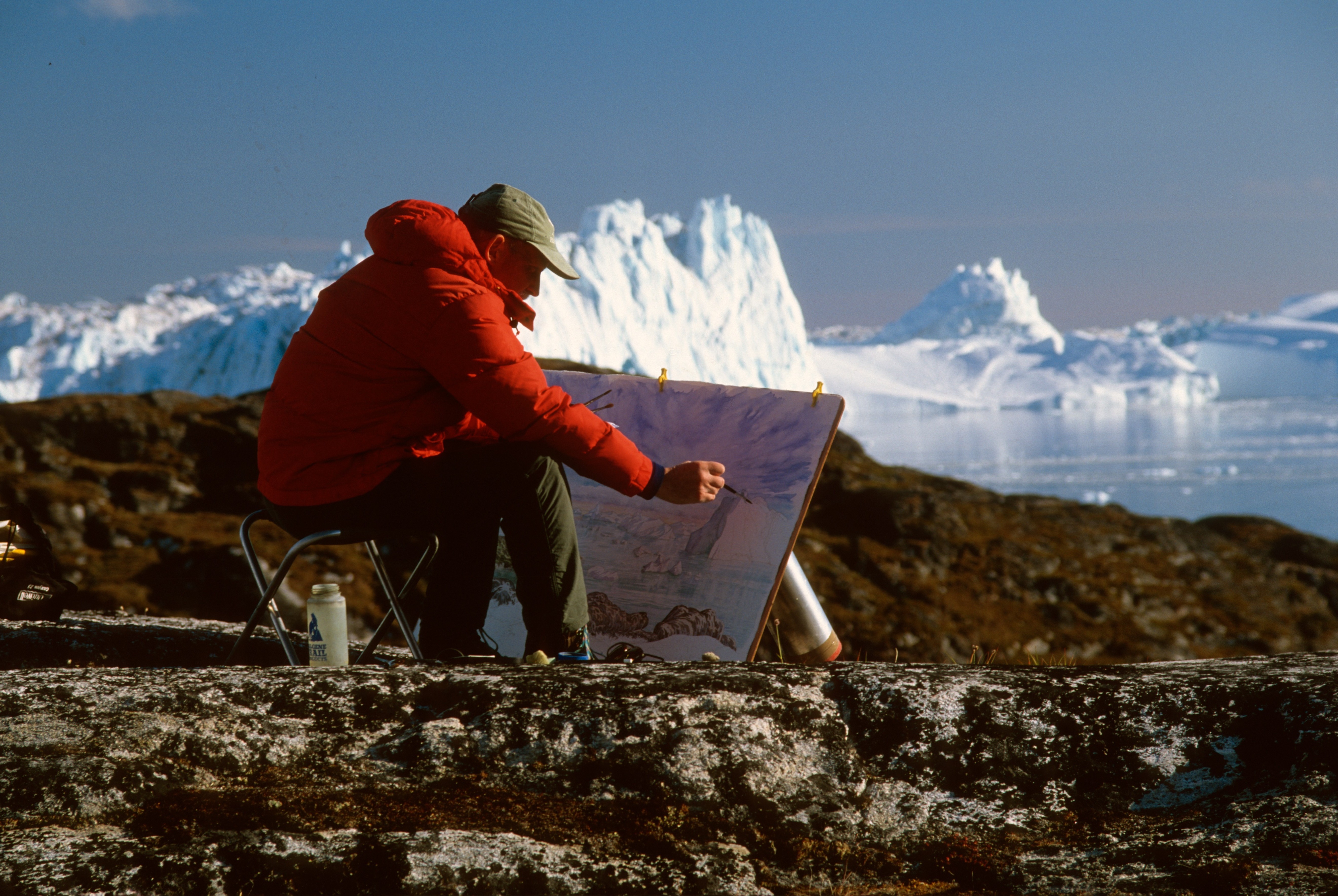
Tony Foster painting in Ilulissat looking across the Kangia Icefjord, Ilulissat, Greenland, Aug 2001. Photo: Peter Murray, courtesy The Foster Museum
Tony Foster is an English painter known for his painting expeditions into the world’s great wildernesses. He creates large scale watercolour works en plein air that closely observe the remote natural world, relatively untouched by humans. His expeditions from Everest to the Grand Canyon and the ocean floor are personal watercolour diaries, reflecting on the concept and experience of wilderness.
Exploring Time: A Painter's Perspective, is a major new touring exhibition of Tony Foster’s painting expeditions into the World's wild places, reflecting on the impact and complexity of ‘time’ on the planet. This exhibition will present over 50 small to large-scale watercolours painted en plein air over many years, sharing the artist's perspective on wilderness and rewilded nature from around the world.
At what age did you start to have an adventurous spirit and did you always see yourself becoming an explorer?
I think I probably always had an adventurous spirit. The only evidence I've got of that is that if my mum would give me egg and bacon to take out and cook outside, I'd far rather go and start a campfire outside and cook my own dinner than eat with my family. So that's the only evidence I have.
And I certainly started camping at an early age, sleeping at different places and so on. But as to the idea of a career as an explorer, I'd never, ever thought about anything like that, and still not sure I do. I suppose I started to realize that it might be the direction my work was going in when I was working in the forest in Maine in the USA. I spent many weeks living up there with a friend of mine and I then realized that wilderness still seemed to exist, much to my surprise. And I thought that it was such an extraordinary thing. I decided I would move my work in that direction. By that time, I was 35 I guess.
The paintings in Exploring Time: A Painter's Perspective, focus on the evidence of time passing on the planet and our increasing impact as humans, even in very remote areas. The exhibition will be divided into four sections - Geological Time, Biological Time, Human Time and Fleeting Moments. What do you hope visitors will learn from experiencing this impressive body of work?
With all my exhibitions I hope that people will learn the extraordinary nature of the planet that we all inhabit, because the Exhibition spans many millions of years through to fleeting moments. It would be good if people realized that our tenancy on the world is very short, compared with the whole sweep of the Earth's history. And perhaps that would make people feel a little more modest and more humble, which wouldn't be a bad thing, a little humility, perhaps, might be a lever to change our rather bombastic opinion as to our place in the world. Perhaps we begin to ponder on why during our very short tenancy of the planet, we proceed to wreck it.
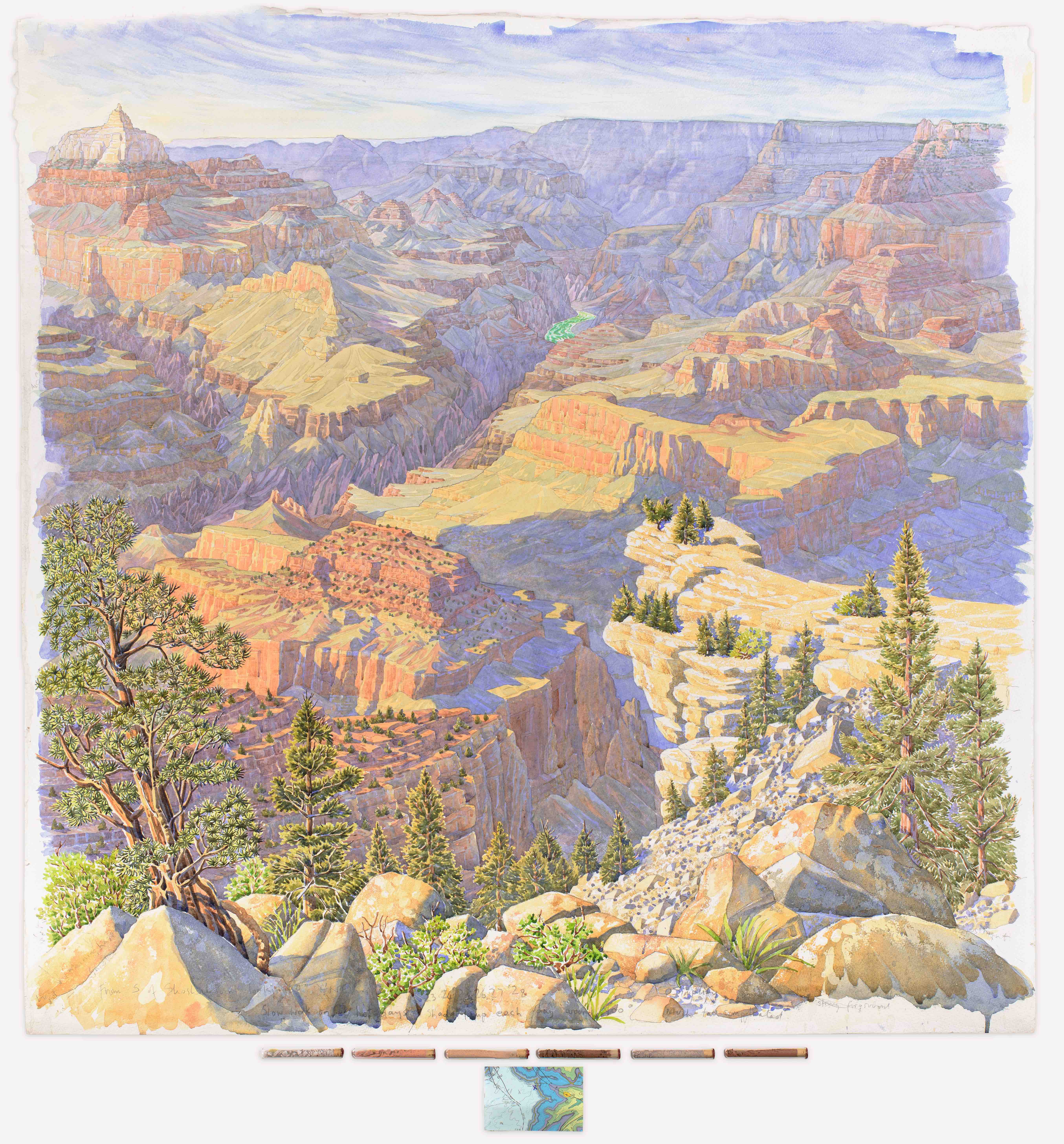
Water Cuts Through Stone · Grand Canyon from Rim to River · 5800ft · c.12-14 Million Years , 2017. by Tony Foster, watercolour & graphite on paper, crushed Grand Canyon rock (in geological order) in glass tubes, cork, sealing wax, map
You describe each work as a ‘journey’ and the watercolour paintings in this exhibition will include diary excerpts, specimens and objects from each expedition. Why have you chosen to display the process of each expedition alongside the paintings?
I suppose, like all kids, I collected interesting things. I proceeded to fill my bedroom with foreign cigarette packets or shells from the seaside or interesting fir cones or whatever I happened to come across. And in a way, I've just grown up doing the same thing. What I have found is that those humble objects that I put in with my work do draw people in, as do the diary notes which I make. They draw people into the process. And having perhaps a little understanding as to how the paintings are made, makes people look at them more closely, and perhaps understand a bit more about my motivation and how the process works. I think people are intrigued by that. And of course, they love the adventure. So if they feel they're drawn into the adventure too, then that's a good thing.
In your forty-year career you have spent time in hundreds of places to observe untouched nature including Mount Everest, the Grand Canyon, the Galapagos Islands, Borneo, Greenland, Guyana,and Dorset’s Jurassic Coast. What has been the hardest and most unforgiving environment to paint?
I'd say the hardest and the longest term engagement has been with Everest, that was when I suffered the first time from acute mountain sickness, and could very easily have died had I not managed to get to a Porter's rescue clinic. So I look back on that as being one of the closest shaves I've ever had. And of course, trying to paint at 18,000 feet in often minus 10 degrees and a howling wind, physically, that's probably the most difficult. But I would also add Death Valley to that. Hiking across Death Valley was a pretty tough experience, too, and not one I'd advise anybody to try. And then, of course, the rainforest also is a hard place to work in that it is very, very, very uncomfortable. It's not necessarily dangerous, but it's certainly uncomfortable, and it takes a lot of getting used to before you feel you can sit there for eight hours a day swatting the bugs and generally feeling attacked by the rain, insects, mud and all the various things that get you in the rainforest. So those three things really but I guess Everest is the toughest of all.
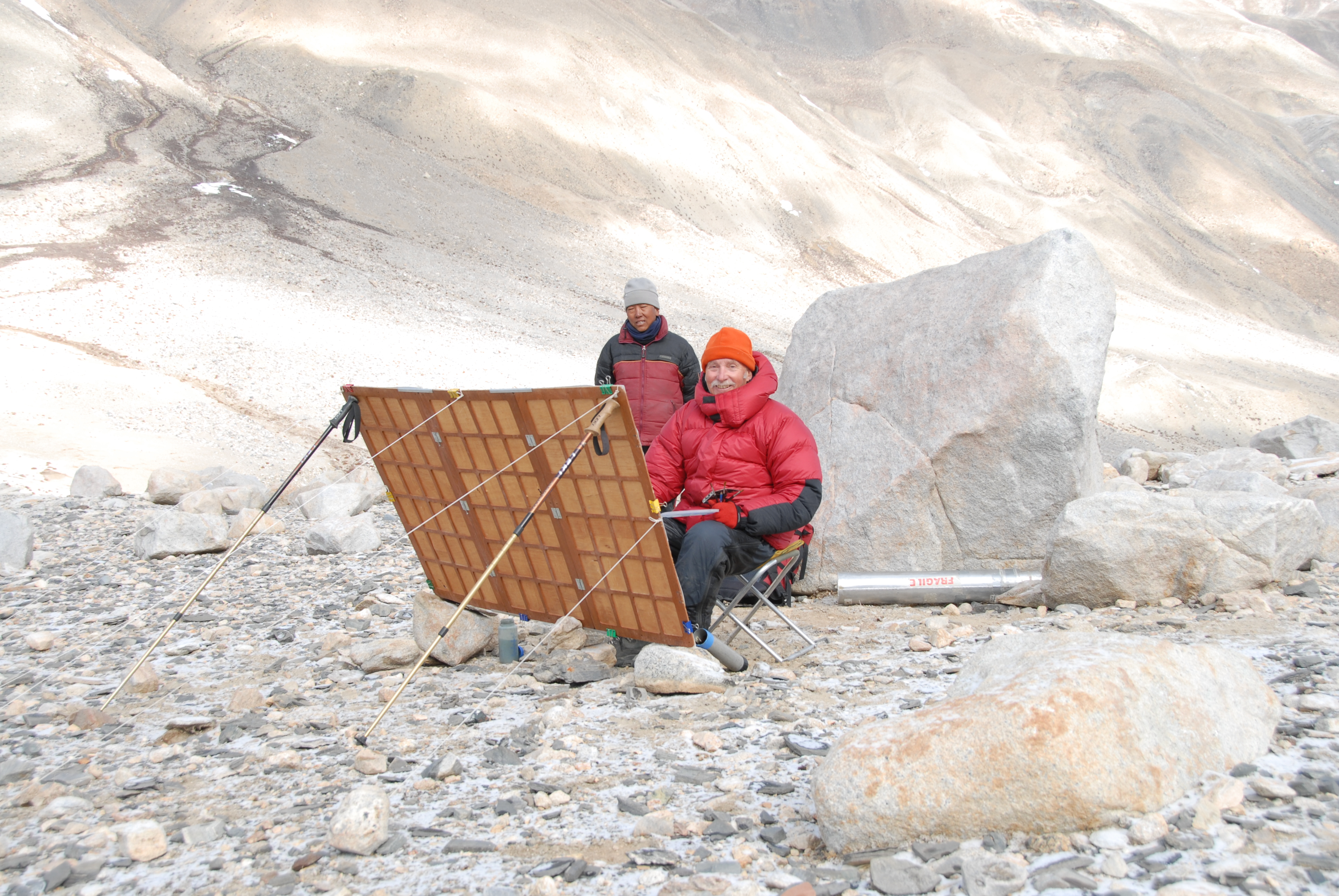
Tony Foster painting Mount Everest, Tibet, with Ang Phuri Sherpa, April-May 2007. Photo: Kurt Ohms, courtesy The Foster Museum
What is it about plein air painting and working directly from the landscape that has kept you inspired throughout your career?
Inspiration, I suppose, is a difficult thing to define. You know, when you get it, but it's hard to know why you've been inspired by a particular thing. Inspiration is a fugitive thing which only comes when it feels like it. Picasso said a wonderful thing about inspiration, which was ‘When inspiration strikes, I hope it will find me working’. I think that is the key to it. Just get on with the work and sooner or later, if you're doing what you're supposed to be doing, you will begin to feel a sense of inspiration.
I suppose the thing about plein air is that I know a lot of painters use photographs, and I never do. A lot of good paintings are done by other people using photographs, but I just have a sense that people recognize, subconsciously, that my work is done outdoors. They feel as if they're breathing fresh air when they see the paintings. Even if they know nothing about making paintings, subconsciously they recognize that. I don't think I've ever done a worthwhile painting from a photograph.
You work solely in watercolour to document your observations. Why do you prefer to use watercolour in your paintings and could you describe the process of approaching a new painting to its completion back at your studio in Cornwall?
The reason I use watercolour is because it’s the most portable medium. The places I go, don’t suit oils. They'd be too heavy to carry. They'd never dry. They'd be stuck with insects and dust and dirt and twigs. Watercolours dry quickly, unless you're in a rainforest, in which case they seldom dry at all. It's just much more practical. And also it's what I've done for 45 years. I guess I'm used to it.
As to the process, I suppose it goes from the concept for the exhibition. That’s the first stage. Something that is going to keep me engaged for several years. I then have to start planning the journeys, to get to the subjects I'm trying to find. I then have to go on the journey and find a site in order to sit down and make the painting. And then I sit down and work on it for as long as absolutely necessary, until it's resolved. In other words, by then it's made the rules about how it's going to be finished back in the studio. That's the short answer to the question.
But actually sitting down and making the painting is, I suppose, what you're interested in, and that's simply a matter of taking an often large sheet of paper, unfolding the drawing board, tethering it to the landscape with guy lines, sitting in front of it, doing a pencil drawing, which can take anything up to three or four days, and then painting it, and working on it for as long as necessary until it's resolved. I then roll it up, put it in an aluminum tube, and cart it back to the studio. Back at the studio it's a matter of pulling the painting together to make it work. In other words, making the foreground come forward and the background go back, getting a sense of distance. In a way, what I come back with after weeks in the field is a painting which looks fresh and in many ways beautiful, but doesn't actually work as a work of art. It has to be made to work pictorially, and that's what I do in the studio, really, I make it work pictorially.
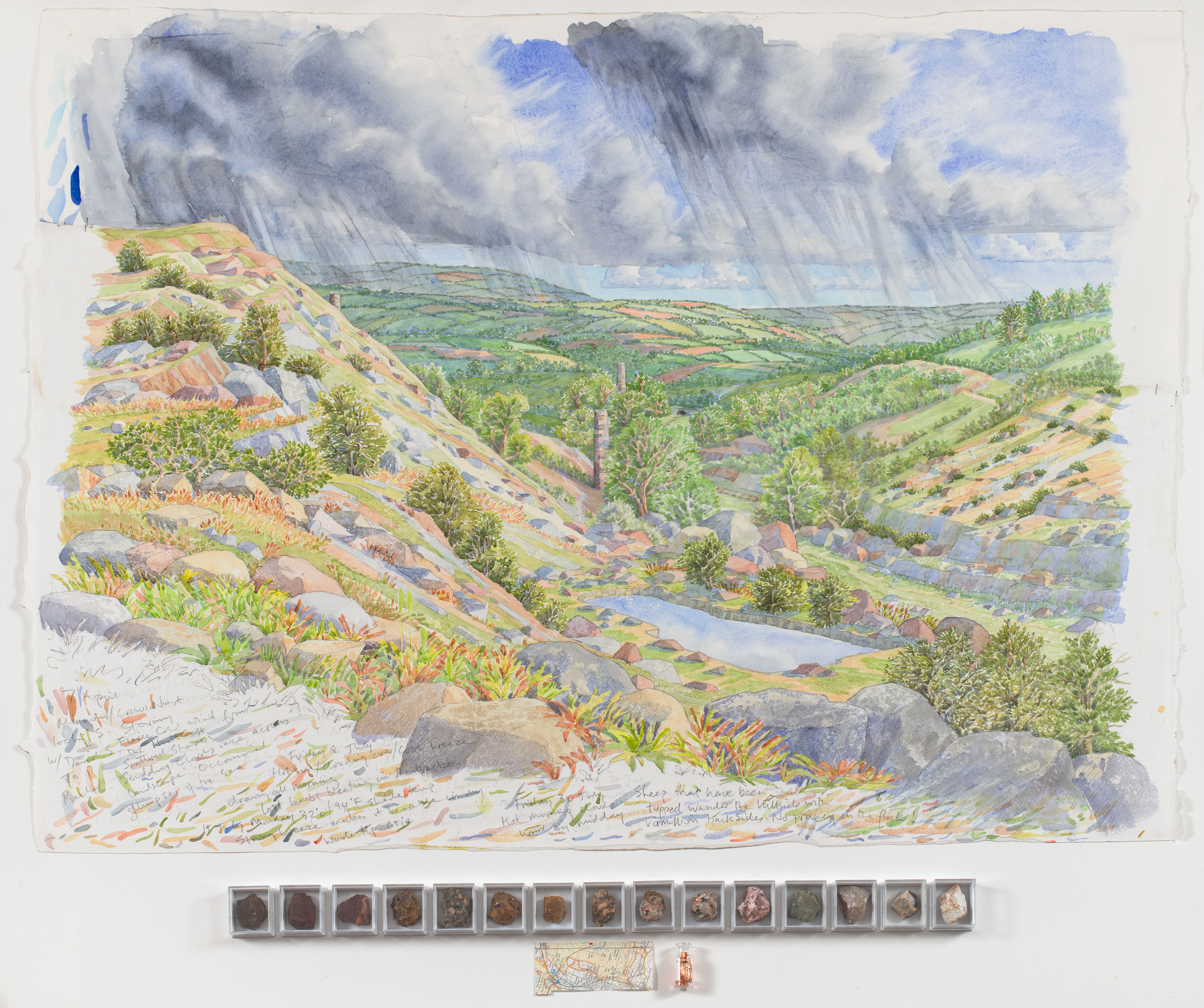
Rewilding: Minions to Crow’s Nest · Copper Mines Abandoned 1914, 2023. by Tony Foster, watercolour & graphite on paper, slag heap samples and miniature Highland bull in acrylic boxes, copper in a glass bottle with cap, map
To work on such a large scale and to produce such intricate and accurate watercolours takes time and meticulous skill. What is the longest you have spent documenting one place and what keeps you focused in your work?
Well, first of all, of course, finding a site - even when you’ve decided the theme of the work you're doing, to find a particular painting, a subject that’s going to inspire you - that can take a long time. I remember when I was looking for a big painting in the Grand Canyon. I wanted to do a six foot painting. You might think that in the Grand Canyon, you only have to look at the place to find the subject of the big painting, but actually no, you really have to hunt. I remember one of the longest times I ever took to find the site was 13 days. And finally, I found the site and did a painting which took, I think, about 10 or 12 days to do. But the longest I've ever taken to actually paint one work was also at the Grand Canyon, and that was an eight foot by four foot painting,. That took 23 days working on site.
What keeps me focused, I guess, is getting my stove out and brewing a cup of tea every two hours. That way I can generally focus for eight to 10 hours a day, without tea I couldn't focus very long.
You have had the opportunity to travel and capture some of the worlds most beautiful landscapes. If you could revisit and paint only one of these unique locations, where would you go?
I guess it would be either the Grand Canyon, because that offers just endless, endless opportunities to make paintings. I mean, there are just so many places in the canyon with wonderful grand vistas. I spent many months on the rim of the Grand Canyon and down inside it. Geologically, it's very obvious how it works, the layers of rock form a sort of scaffolding that you can use. So the Grand Canyon, I guess, is my first choice. Everest is my second choice because, although it's a tough place to be, nonetheless, the relationships I built with the Sherpas. I went four times to the Himalayas, with the same people, same cook, same porters, same Sirdar, same Sherpa Guides, and built up wonderful relationships with them. I'd love to see them all again.
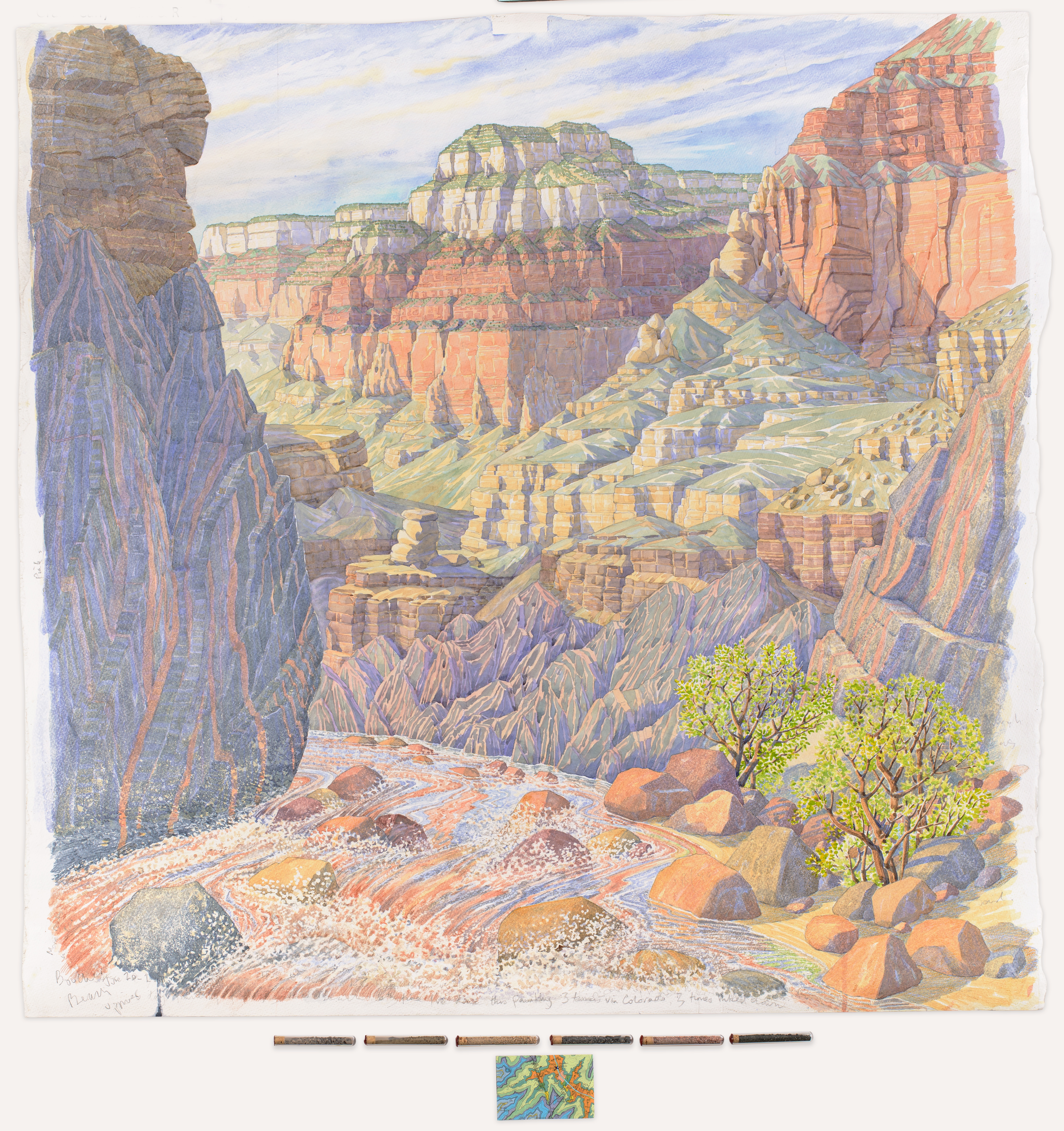
Water Cuts Through Stone · Grand Canyon from Rim to River · 5800ft · c.12-14 Million Years , 2017. by Tony Foster, watercolour & graphite on paper, crushed Grand Canyon rock (in geological order) in glass tubes, cork, sealing wax, map
What does your kit look like when painting en plein air, and what would you say are your absolute essentials? Do you have any advice for artists wanting to start working outside?
It looks like cast offs that you might find in a junk shop, really. I have a folding drawing board, I have two or three actually, but the one I use most is one that’s six feet by three. I use Bockingford paper. That's rolled into an aluminum tube to protect it. And then I have my hiking poles, which prop up the drawing board. It's lashed to the landscape with guylines. And then the paints - I use a Windsor and Newton Bijou number 2 paint box, which is absolutely tiny, about the size of a pack of cigarettes. I have the top of a Tupperware lid as a mixing palette, because it's light, it bends and it fits into a backpack. I have a Frank Herring painting stool. If I were to give anybody any advice, I'd say, find something comfortable to sit on, because otherwise you're not going to stay very long doing your work before you start complaining about your backside. So the Frank Herring studio painting stool is the most useful object you could possibly have if you're painting outdoors. He doesn't manufacture them anymore. If you can find a secondhand one, buy it. Perhaps, if we all got together, we could persuade Frank Herring to start making them again, they're marvelous.
Your paintings celebrate both the wonder and fragility of nature, highlighting the importance of leaving areas of the world undisturbed. What is your advice to painters wanting to explore and capture their environment in a respectful and harmless way?
Well, I've always stuck to the idea of Leave No Trace. I'm camping in order to make my work so it's very important that when you break camp, take everything away. Obviously, carry all your garbage out with you, and tidy the site up as best you can. Okay, you'll flatten the grass a bit, but make sure that there's as little trace as possible
I can't say that my life has been harmless to the environment, because I've certainly used up my CO2 portion, but I hope that whatever good I might have done by showing and proselytising about the extraordinary places I have been privileged to work in will balance out the harms.

Tony Foster painting while perched on a rock in the middle of the San Juan River, Utah, May 2011. Photo: Barbara Windham, courtesy The Foster Museum
Tony Foster’s new exhibition, Exploring Time: A Painter’s Perspective, will open at RWS Gallery on 7 November 2025.
___________________________________________________________________________________________________________________________________________________________________________
RWS Gallery at Whitcomb Street
3 - 5 Whitcomb Street
London, WC2H 7HA
Free Admission
Open daily 11am - 5pm
For all enquiries please contact info@thefoster.org
